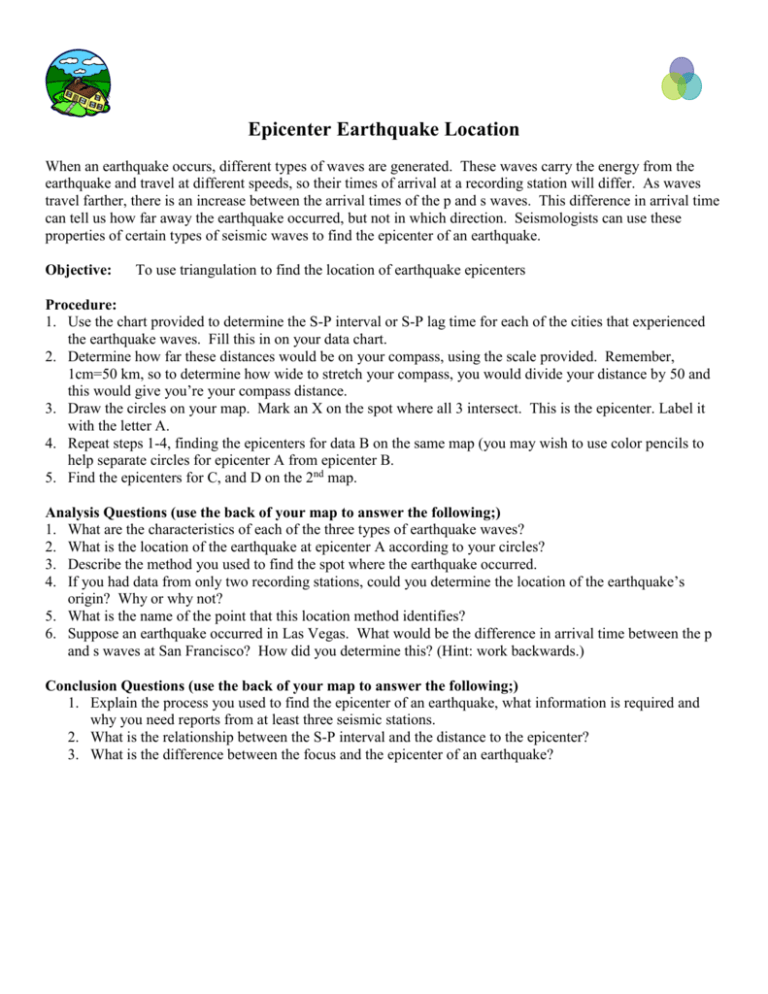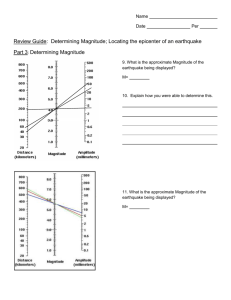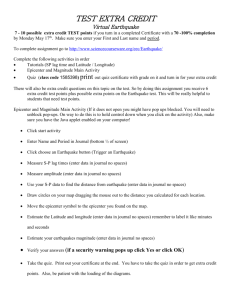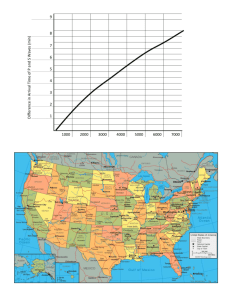ì - MrTestaScienceClass
advertisement

Epicenter Earthquake Location When an earthquake occurs, different types of waves are generated. These waves carry the energy from the earthquake and travel at different speeds, so their times of arrival at a recording station will differ. As waves travel farther, there is an increase between the arrival times of the p and s waves. This difference in arrival time can tell us how far away the earthquake occurred, but not in which direction. Seismologists can use these properties of certain types of seismic waves to find the epicenter of an earthquake. Objective: To use triangulation to find the location of earthquake epicenters Procedure: 1. Use the chart provided to determine the S-P interval or S-P lag time for each of the cities that experienced the earthquake waves. Fill this in on your data chart. 2. Determine how far these distances would be on your compass, using the scale provided. Remember, 1cm=50 km, so to determine how wide to stretch your compass, you would divide your distance by 50 and this would give you’re your compass distance. 3. Draw the circles on your map. Mark an X on the spot where all 3 intersect. This is the epicenter. Label it with the letter A. 4. Repeat steps 1-4, finding the epicenters for data B on the same map (you may wish to use color pencils to help separate circles for epicenter A from epicenter B. 5. Find the epicenters for C, and D on the 2nd map. Analysis Questions (use the back of your map to answer the following;) 1. What are the characteristics of each of the three types of earthquake waves? 2. What is the location of the earthquake at epicenter A according to your circles? 3. Describe the method you used to find the spot where the earthquake occurred. 4. If you had data from only two recording stations, could you determine the location of the earthquake’s origin? Why or why not? 5. What is the name of the point that this location method identifies? 6. Suppose an earthquake occurred in Las Vegas. What would be the difference in arrival time between the p and s waves at San Francisco? How did you determine this? (Hint: work backwards.) Conclusion Questions (use the back of your map to answer the following;) 1. Explain the process you used to find the epicenter of an earthquake, what information is required and why you need reports from at least three seismic stations. 2. What is the relationship between the S-P interval and the distance to the epicenter? 3. What is the difference between the focus and the epicenter of an earthquake? Find the location of epicenter A if the stations below report the following data: City Carson City, NV S-P Lag time (seconds) 36 Sacramento, CA 31 Monterey, CA 46 Distance (km) Distance (cm) (D in km/50) Find the location of epicenter B if the stations below report the following data: City Elko, NV S-P Lag time (seconds) 31 Klamath Falls, OR 46 Reno, NV 52 Distance (km) Distance (cm) (D in km/50) Find the location of epicenter C if the stations below report the following data: City Medford, OR S-P Lag time (seconds) 42 Monterey, CA 33 Boise, ID 55 Distance (km) Distance (cm) (D in km/50) Find the location of epicenter D if the stations below report the following data: City Klamath Falls, OR S-P Lag time (seconds) 46 Las Vegas, NV 62 Ely, NV 66 Distance (km) Distance (cm) (D in km/50)







